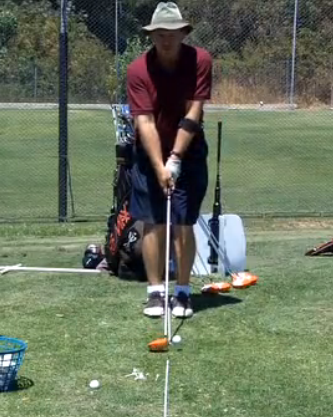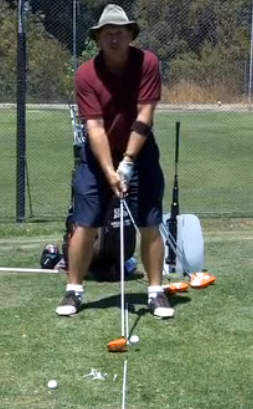In this video I’ll show how I get more distance off the tee by optimizing the position of the golf ball in my stance.
One of the keys to consistent golf shots is making consistent center contact – hitting the ball on the sweet spot in the middle of the club face.
Watch the video to see how I use a couple of alignment rods to help me square up to the ball at address, and to make sure that the golf ball is positioned exactly where it need to be to get the best results – more distance!
I’m not as big or as strong as most of the guys I compete against in Long Drive so I can’t afford to give up a single mile-per-hour of ball speed.
OPTIMIZING RESULTS WITH RADAR FEEDBACK
I’m fortunate to have John Greenwood helping me. Not only does he build my drivers, but he brings his radar to the range to help me train.
Last year as I trained for the 2012 World Long Drive Championship we experimented with ball position. The Geek Golf “No Brainer” club head I use is a little heaver than most drivers.
What we found was that the release point of the No Brainer was a little earlier than my other drivers. By moving the ball back an inch and a half in my stance my ball speed went up 6 mph and I gained an additional 10 yards.
There’s no way we would have known that for sure without radar.
Radar training is going to be the next Big Thing in golf. I’ll have a lot more to say about that in future posts and how it will benefit every golfer. Radar training is going to fundamentally change golf instruction as we know it.
POSITION THE GOLF BALL CORRECTLY IN YOUR STANCE
To make sure the golf ball is positioned correctly in my stance I put down a couple of alignment rods perpendicular to my target, making sure they are dead square.
I leave a little gap between them where I tee up the ball.
The rods are positioned at the back edge of the golf ball.
BALL POSITION CHECKLIST
That allows me to do three things:
1. Make sure my club head is aligned properly to the target;
2. Ensure my stance is square to the target line; and
3. Position the ball exactly where I want it in my stance, every time.
To begin I hit a couple of 10-ball sets with the driver, experimenting with ball position just to make sure that the adjustment we made last year still produced the ball speed numbers we were looking for.
The inch-and-a-half adjustment was still ideal, producing the best ball speed results.
After that it was simply a matter of practicing my routine on every shot to make sure the ball was where I needed it.
TAKE AWAYS:
1. Use alignment rods to make sure the golf ball is positioned in exactly the same place in your stance every time;
2. Radar training provides instant feedback with real results, eliminating guesswork and allowing you to have confidence in the adjustments;
3. Once you know the ideal ball position, practice your pre-shot routine until it becomes automatic.




Maybe you’ll touch on this subject in a later video but I am curious about weight distribution. It appeared that your weight was evenly distributed but I’ve heard about adjusting your spine angle away from the target while having more weight on your back foot/leg. Can you expound on this?
Post author
Hi Gil,
Thanks for your question on weight distribution. Let me make a few overall comments.
First, the classic address position puts the spine at about a 5 degree tilt away from the target. That’s the only way to keep the left arm straight and the right arm slightly bent at address and to see the back of the ball – where you’ll be making contact. That tilt may produce a slightly greater weight distribution to the right side at address, although I always feel like my weight is balanced.
Secondly my philosophy is to always err on the side of athleticism. If it makes you more athletic and improves your ball striking – do it! Everybody’s physiology and physical capabilities are different. The classic stance and set-up is a starting point. The only reason I make a change is if it improves one (or more) of the four ultimate performance metrics: Center Contact, Directional Accuracy, Distance Control, and Shape Control.